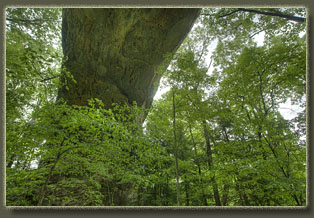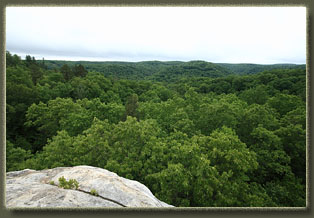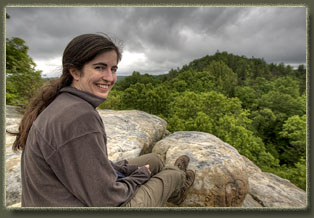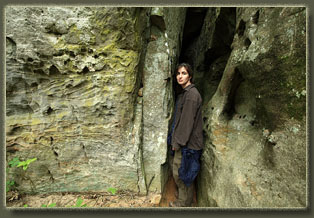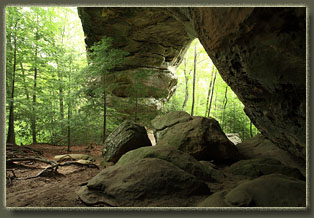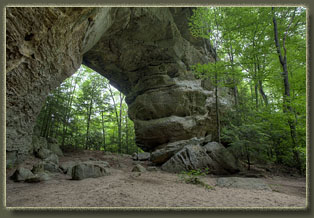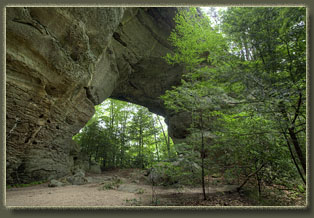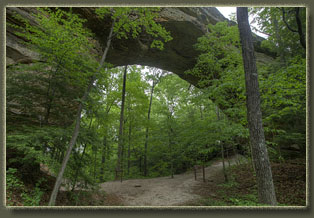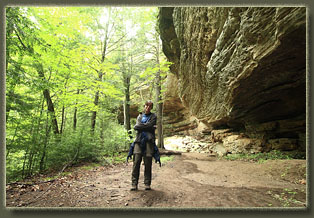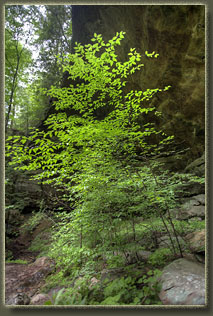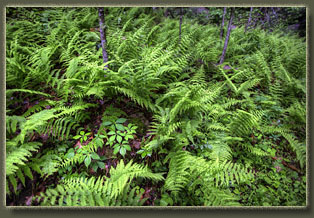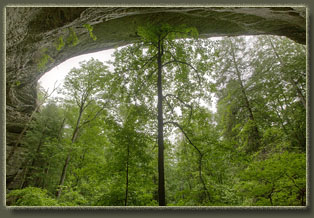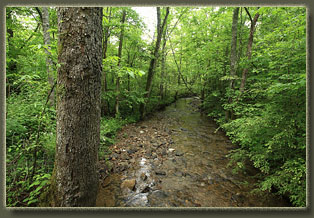| Twin Arches
and Slave Falls
Location: Big
South Fork National Recreation Area, on the Kentucky-Tennessee border near
Jamestown, TN
May 15, 2011 Itís rainy, drizzly and cool, with a temperature hovering in the mid-50ís. Not so bad, really, after a week of upper 80ís. We cruise along Hwy 154 with the wipers on medium, wiping away the accumulating drizzle from the grey sky above. In less than a month, weíll be moving from Tennessee back to Wyoming, and the list of Tennessee hikes, compiled from guidebooks, recommendations from friends and internet browsing that Iíd planned on having years to complete has suddenly become very urgent. Big South Fork has been on that list nearly since I moved here, and so with this rare day that offers both a babysitter (Karen) and no work duties, we decide to head north and check it out. There are lots of places to hike in the Big South Fork National Recreation Area, and I canít even hope to do more than scratch the surface with this trip. I pick out one of the closer hikes that sounds interesting, and we arrive at the trailhead around 10:30, just Andra and I. There are only a few other cars in the lot, whether due to inclement weather or a lack of popularity, I donít know. But once we get on the trail, we see only 6 people in the next 6 hours. The trail is obvious enough, and lined with pink and white-blooming rhododendrons, with a canopy of the usual Tennessee hardwood cadre: tuliptrees, hickories, red oaks, white oaks and, in special abundance in this area, sourwood, blackgum, sassafrass, blackgum and bigleaf magnolia. The bigleaf magnolia are awesome, and Iíve never seen them as big as they grow here, reaching heights of 40 feet, with leaves 2 feet long. Near the beginning of the trail, just off of it in fact, we spot a small American chestnut tree, still hanging on from a root system intact after decades of blight. We hike on down, taking a clockwise approach at the first junction, and descend very steep stairs to the dark, wet forest below. In short order, we are at the north arch, admiring it, watching it, walking under it. The arch is huge, and seems like a piece of Utah plunked down in the Cumberland Plateau. Very unusual. Thereís a set of stairs that run up the far side of the arch, and we take them, walking up on top over the arch, looking down on the forest below, and then continuing on to a series of steps that leads back to the parking lot. Weíre not ready for that yet, so we head the other way, over the south arch and up to the summit above the arch, where a fine view of unbroken forest undulates before us to the horizon where it meets the grey sky. We descend back down the steps to the area below the arches, and explore the south arch, which is more open and broader in width than the northern arch. To the west of the arch there is a dark crevice that I approach, though it appears to go nowhere. I am about to turn back when I spot a glow of light from within and, approaching closer, see that this is in fact a narrow tunnel that leads 30 feet through to the other side. I call to Andra, and we both take the dark route, finding the walls inside completely obscured by darkness. On the other side, we tarry but a minute, and I return via the tunnel while Andra walks around the west side of the open rock. We return to the trail junction
beneath the north arch, and head towards Jakeís Place. The next hour of
hiking is some of the most pleasant hiking Iíve found in Tennessee. Splendid
high walls of pocked sandstone, varying in height from 20 to 100 feet,
draped with vines and veiled by the delicate leaves of giant hemlocks,
line the right side of the trail as it weaves through the forest, sidling
up now and again to the rock walls, and under alcoves where trees grow
stunted under the rock cap above, and water drips down through fissures
and faults in the rock. Waist-high cinnamon ferns line parts of the trail.
Itís a damp, humid forest that puts me in a mind that weíre in coastal
Washington.
We reach the open meadow of Jakeís Place, and notice the heady aroma of wild roses, smelling something like citronella, but sweeter. In the humid air, the scent carries far. We head through the trees towards Slave Falls, on a trail that is gumbo mud, sticky and deep. Some portions of the route have wooden planks across them to elevate hikers out of the mud, but most of the time we are slogging through sticky muck. The route follows a beautiful small stream through thick, dark forest with tree trunks coated in moss. Coleus completely carpets sections of the area, resulting in brilliant green on the forest floor, where typically there is mostly the brown of fallen leaves. Slave Falls is a thin, completely free-falling stream of water that drops from the roof of a vast alcove, and is thus far removed from the nearest cliff wall. I couldnít find a definitive height, but it appears to be around 60í high. A light drizzle started just as we arrived at the waterfall, so Andra and I walk up under the alcove to the north and stake out a relatively dry spot to eat lunch and watch the water pour down. Chilled from sitting, we hit the trail and briskly walk downstream back to Jakeís Place. At the trail junction, we take a right turn, and continue on the Twin Arch Loop through more lush forest to Charit Creek Hostel, which appears to be closed yet for the season. We head uphill through the woods, gaining elevation rapidly on round-log steps that are slick with the mist that comes and goes. Gore-Tex boots are terrible on wet wood, and we both slip several times on the steps. Reaching the arches, we find
the small tunnel under the steps that lead to the top of the arches, each
of us going through from opposite directions before returning the stairs
and reaching the point above the arches. From there we complete the loop
to the parking lot by heading up the stairs. Just as we reach the car,
real rain sets in, and I jump in the car quickly after changing my damp
shirt. What timing!
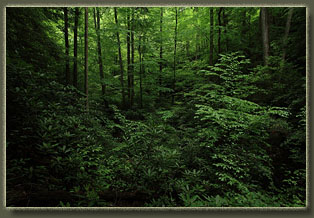
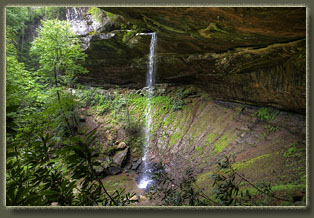
Slave Falls 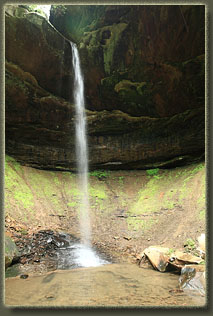
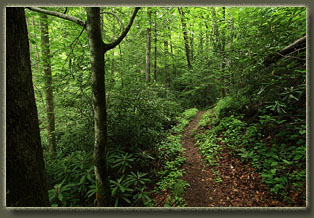
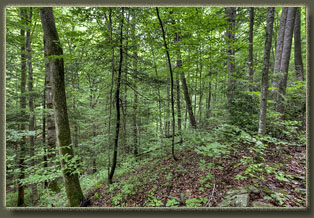
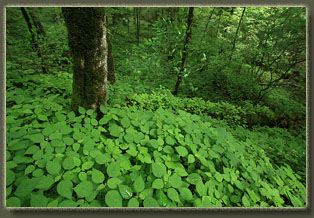
Choleus carpet of green 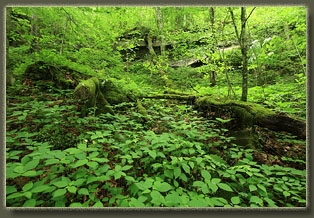
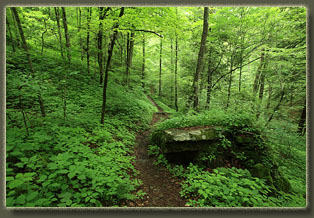
Green, green everywhere 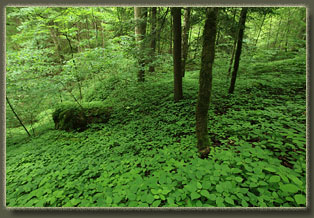
Like walking in a terrarium 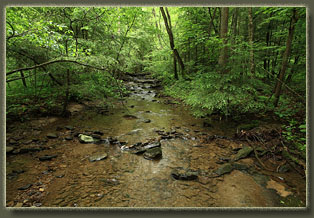
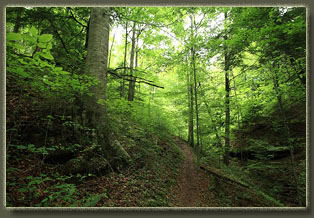
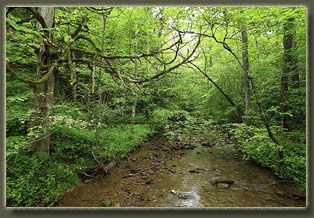 |
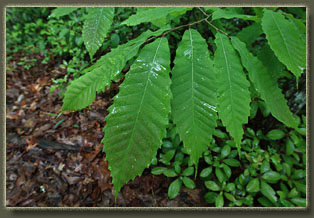
American chestnut 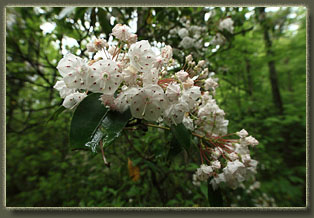
Rhododendrons in bloom 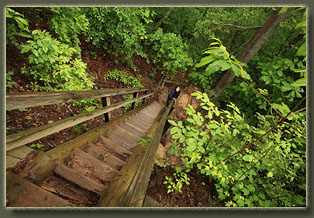
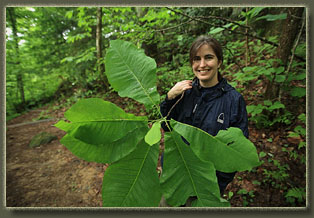
Bigleaf magnolia 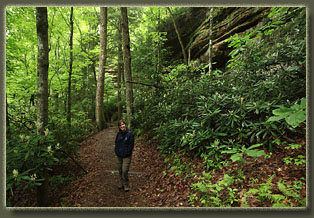
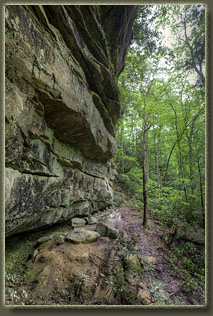
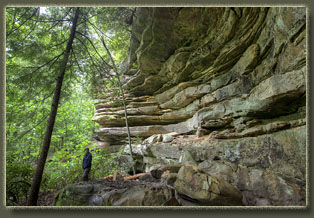
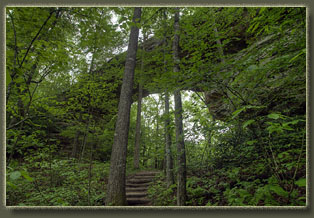
North Arch
|
